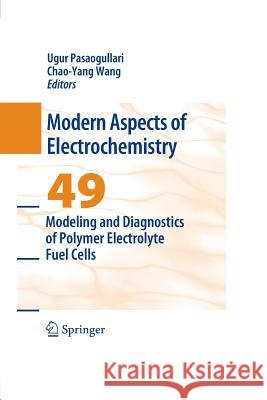Modeling and Diagnostics of Polymer Electrolyte Fuel Cells » książka
Modeling and Diagnostics of Polymer Electrolyte Fuel Cells
ISBN-13: 9781489982636 / Angielski / Miękka / 2014 / 397 str.
Polymer electrolyte fuel cells (PEFCs) or proton exchange m- brane fuel cells (PEMFCs) have been suggested as alternatives to replace many existing energy conversion technologies, incl- inginternalcombustionenginesandbatteries.Themostsigni?cant advances in PEFC technology achieved in the last decade have occurredinareasrelatedtoautomotiveapplications, namelyco- start capabilities, enhanced durability and better understanding of watermanagementandmasstransportlosses. This volume of Modern Aspects of Electrochemistry is intendedtoprovideanoverviewofadvancementsinexperimental diagnosticsandmodelingofpolymerelectrolytefuelcells.Chapters byHuangandReifsniderandGuetal.provideanin-depthreview of the durability issues in PEFCs as well as recent developments in understanding and mitigation of degradation in the polymer membraneandelectrocatalyst. Enabling cold start, the startup of PEFC stacks from subzero temperatures, is a very important capability achieved only within thelastfewyears.TajiriandWangprovideatutorialoverviewofthe requirementsforcoldstart, andprovideasummaryofexperimental diagnosticsandcold-startmodelingstudies. Chapters 4 6 address speci?c diagnostic methods in PEFCs. Martin et al. provide a detailed review of methods for distributed diagnostics of species, temperature, and current in PEFCs in Chapter 4.In Chapter 5, Hussey and Jacobson describe the op- ationalprinciplesofneutronradiographyforin-situvisualizationof liquidwaterdistribution, andalsooutlineissuesrelatedtotemporal andspatialresolution.TsushimaandHiraidescribebothmagnetic resonance imaging (MRI) technique for visualization of water in PEFCsandtunablediodelaserabsorptionspectroscopy (TDLAS) formeasurementofwatervaporconcentrationinChapter6. Diffusionmedia(DM)areproneto?oodingwithliquidwater. AlthoughtheDMisanessentialcomponentofPEFCsthatenable distributionofspeciesandcollectionofcurrentandheat, littlewas knownaboutcapillarytransportinDMsuntilrecently.InChapters7 Gostick et al. provide a description of liquid water transport in porousDMduetocapillarityanddescribeexperimentaltechniques usedtocharacterizeDMproperties. v vi Preface The?naltwochaptersdiscussmodelingofPEFCs.Mukherjee and Wang provide an in-depth review of meso-scale modeling of two-phase transport, while Zhou et al. summarize both the s- ulation of electrochemical reactions on electrocatalysts and the transport of protons through the polymer electrolyte using at- isticsimulationtoolssuchasmoleculardynamicsandMonteCarlo techniques. Eachchapterinthevolumeisself-contained;thereforetheydo notneedtobereadinacertainorder. Special thanks are due to 23 authors who contributed to this volume











